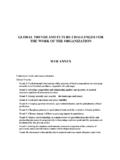Transcription of IV. DEMOGRAPHIC PROFILE OF THE OLDER …
1 world population ageing 1950- 2050 population Division, DESA, united nations 23 IV. DEMOGRAPHIC PROFILE OF THE OLDER population A. AGE COMPOSITION OLDER populations themselves are ageing A notable aspect of the global ageing process is the progressive DEMOGRAPHIC ageing of the OLDER population itself. For most nations , regardless of their geographic location or developmental stage, the 80 or over age group is growing faster than any younger segment of the OLDER population . At the global level, the average annual growth rate of persons aged 80 years or over ( per cent) is currently twice as high as the growth rate of the population over 60 years of age ( per cent) (figure 23). Although the growth rates of both age groups are expected to decline over the next 50 years, by 2045-2050 the growth rate of the over-80s ( per cent) will still be almost double that of the over-60s ( per cent).
2 In 1950, 1 in 15 persons aged 60 or OLDER was 80 or above; in 2000, this ratio increased to 1 in 9 and by 2050 it is expected to increase to approximately 1 in 5 (figure 24). The most remarkable increase is expected to occur in Japan where, in 2050, more than 1 in every 3 persons aged 60 or over will be at least 80 years old. Numbers of persons aged 80 or over are increasing substantially Those 80 or over are now only slightly more than 1 per cent of the total human population . This proportion is projected to increase almost fourfold over the next 50 years, to reach per cent in 2050. Currently, only one country, Sweden, has more than 5 per cent in this age group. By 2050 the over-80 age group is projected to number almost 379 million worldwide, about times as many as in 2000 (69 million persons).
3 In 1950, persons over 80 numbered less than 14 million (figure 25). Six countries contain more than half of the world s oldest-old population Currently, six countries account for 54 per cent of the total number aged 80 years or over. They are China, with the largest number (12 million), united States of America (9 million), India (6 million), Japan (5 million), Germany (3 million) and Russian Federation (3 million). In 2050, six countries will have more than 10 million Figure 23. Average annual population growth rate at ages 60 or over, 65 or over and 80 or over: world , 1950-20500123451950-551975-802000-052025 -302045-50 Percentage60 or over65 or over80 or overFigure 24. Distribution of population aged 60 or over by age groups: world , 1950-20500204060801001950197520002025205 0 Percentage60-6970-7980+ world population ageing 1950-2050 24 population Division, DESA, united nations people aged 80 years or over: China (99 million), India (48 million), united Sates of America (30 million), Japan (17 million), Brazil (10 million) and Indonesia (10 million).
4 Together they will account for 57 per cent of all those 80 or over in the world . The proportion of persons over 80 is significantly higher in the more developed regions People 80 or OLDER currently constitute more than 3 per cent of the population of Northern America and almost 3 per cent of the population of Europe, compared with less than per cent in Asia and in Latin America and the Caribbean, and less than per cent in Africa. A regional difference is projected to persist over the next 50 years. By 2050, about 1 in 10 individuals will be aged 80 or OLDER in the more developed regions, while the corresponding ratio will be 1 in 30 in the less developed regions. In the least developed countries only 1 in 100 persons will be 80 or over. In 2050, 19 countries, mostly in Europe, are projected to have at least 10 per cent of their population aged 80 years or over.
5 Most people above 80 years now live in the more developed regions; soon the majority will live in the less developed regions In the year 2000, the majority of people over 80 in the world (53 per cent) lived in the more developed regions (figure 26). In the course of the next half century, however, the population aged 80 years or over is expected to grow significantly faster in the less developed regions. In some developing countries such as Republic of Korea and Singapore, the number 80 years or OLDER is projected to increase by a factor of about ten from 2000 to 2050. As a consequence, by 2025, 57 per cent of the world s population aged 80 years or OLDER will be living in the less developed regions. By 2050, this proportion will increase to more than 70 per cent (figure 26).
6 By 2050, the number of centenarians is expected to increase eighteen times Although the proportion of people who live beyond the age of 100 is still very small, their number is growing rapidly. In 2000, there were an estimated 180,000 centenarians throughout the world . By 2050 they are projected to number million, an increase of about eighteen times (figure 27). Currently, the great majority of centenarians (78 per cent in 2000) live in the more developed regions, and a substantial majority of them (68 per cent) are projected to be living in the more developed regions by the year 2050. Despite the smaller proportion of centenarians in the less developed regions, a significant increase in the absolute number of persons in this age group is projected to take place Figure 25.
7 population aged 80 or over: world , illio nsFigure 26. Distribution of world population aged 80 or over by development regions, 1950-20500204060801001950197520002025205 0 PercentageMore developed regionsLess developed regions world population ageing 1950- 2050 population Division, DESA, united nations 25 in these regions over the next 50 years, from 40,000 in 2000 to more than 1 million in 2050. Within the more developed regions, Japan, in particular, will experience a remarkable increase in the number of centenarians over the next half century, from less than 13,000 in 2000 to almost 1 million in 2050. By the end of this period, Japan is expected to have by far the world s largest number and proportion of centenarians. Nearly 1 per cent of Japan s population will be 100 years old or OLDER . B. SEX RATIO Women make up a significant majority of the OLDER population ; the female share increases with age Because their life expectancy is greater than men s, women comprise a significant majority of the OLDER population .
8 In the year 2000, the global sex ratio of the population aged 60 or over was 81 males per hundred females (figure 28). Thus, there were approximately 63 million more women aged 60 years or OLDER than there were men of the same age. Since female mortality rates are lower than male rates at OLDER ages, the proportion of women in the OLDER population grows substantially with advancing age. In 2000, women outnumbered men by almost 4 to 3 at ages 65 or OLDER , and by almost 2 to 1 at ages 80 or above. Sex ratios at OLDER ages are expected to rise globally over the next half century The sex ratios of the world population aged 60 or over and 65 or over remained practically the same in 2000 as they were in 1950. After a slight decline, from 80 men per hundred women in 1950 to 78 in 1975 at ages 60 or over, and from 76 to 74 at ages 65 or over, the world s sex ratios returned in 2000 to the original levels of 1950 (figure 28).
9 In the case of the population aged 80 or over, however, the sex ratio consistently declined over the whole 50-year period, from 61 in 1950 to 58 in 1975 and to 53 in 2000. Over the next half-century, the sex ratio of the OLDER population is expected to increase. The evidence on which the projections are based suggests a somewhat faster growth in life expectancy among men than among women, particularly in the more developed regions. In 2050, the global number of men per hundred women is projected to rise to 85 at ages 60 or over, to 81 at ages 65 or over, and to 61 at ages 80 or over. Sex ratios at OLDER ages are significantly lower in the more developed regions than in the less developed regions In the more developed regions, large gender differences in longevity translate into very low Figure 27.
10 Distribution of world centenarians by development region, 2000-2050 0500100015002000250030003500200020252050 ThousandMore developed regionsLess developed regionsFigure 28. Number of men per hundred women at ages 60 or over, 65 or over, and 80 or over: world , 1950-2050 0204060801001950197520002025205060 or over65 or over80 or over world population ageing 1950-2050 26 population Division, DESA, united nations sex ratios among the OLDER population . Currently, in these regions, there are an average of 71 men per every hundred women in the 60 or over age group and only 44 men per hundred women in the 80 or over age group (figure 29). In the less developed regions, OLDER women do not outnumber OLDER men to the same extent since gender differences in life expectancy are generally much smaller.












